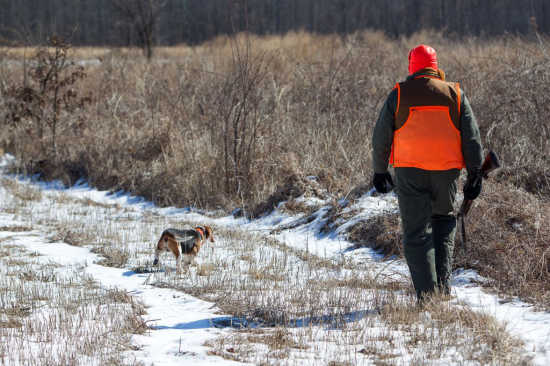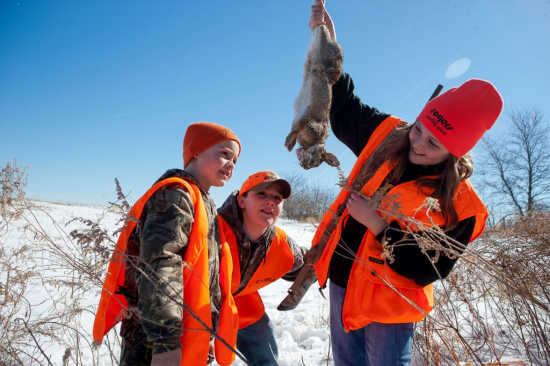- Missouri campgrounds resurgence (5/30/20)
- August a fantastic month for catfishing (8/11/18)
- Kayaking, canoeing good way to spend hot summer days (7/27/18)
- Hot weather means hot catfishing (7/7/18)
- Boat buyers have abundant options (6/16/18)
- Warm weather invites camping (6/9/18)
- Topwater fishing is a blast (6/2/18)
Snow presents challenges for wildlife and humans alike
Saturday, December 31, 2016

The recent snow brought out rabbit hunters and their beagles.
(Photo courtesy of the Missouri Department of Conservation)
In visiting with a neighbor this past week, he reminded me that the recent snow and cold isn't all that bad for an outdoorsman.
"It's a great time for checking where the wildlife are by finding their tracks in the snow. Many people would be surprised to see how many birds and animals are closer than they might think and, for the hunter, he can see how and where deer, rabbit and other game animals spend their winter."
More people are participating in such winter sports as old-fashioned sled riding, ice skating, photography, ice fishing and just hiking in cold and snowy weather.
I remember when, after a snow, our teacher in grade school would take the class outside and check for wildlife tracks, then see how many tracks the students could identify. It can be a fun outing and surprising just how many animals have traveled through the snow.
A lot of people complain as they dig with their snow shovels. We seem to forget that in the world of plants and wildlife, snow is not a nuisance, but rather as welcome as rain and sun. Snow is an insulator, a warm shelter and, in some cases, a vital stepladder.
We have seen places where rabbits have nearly eaten themselves out of food. Every small branch had been snipped off with rabbit bites. However, the next snow fall elevated the rabbits to a higher level so they could reach another tier of food.

Three successful youngsters check out their rabbit while hunting in the snow. (Photo courtesy of Missouri Department of Conservation)
Birds and other wildlife have developed some devices to deal with snow. A few animals have been forced to make use of the snows poor conductivity of heat. Several species of birds and other small animals burry under the snow, as the snow helps hold in their body heat.
For example, quail flutter their wings and wedge themselves into a snow pocket. Of course, the danger can be the crusting, if the birds get iced under the snow. If the crust hasn't thawed out within a day or so, they may never get out.
For the wildlife that are unspecialized in dealing with the snow, a new environment is created that they must cope with. Deer, rabbits and squirrels beat down trails to make the traveling easier, just as people shovel their walks.
To an animal with hooves, heavy snow can mean danger. Coyotes have found the hunting easier for them when there is a heavy snow along a light crust, which is strong enough to bear them, but too thin to support a deer. A coyote will chase a deer off its trail and bog it down in the deep snow, where the coyote can easily take the deer.
Many wildlife photographers look forward to a snow storm that will offer photo opportunities, unlike "normal" weather. The snow dramatically changes the way the world looks and invites picture taking. Bright, sunny days invite picture taking, but many people ignore the unique and interesting possibilities for photography that "bad" weather creates.

A trophy buck in an icy field. (Photo by Ken White/Special to the Daily Mail)
Winter camping is "real" camping, with tents set up right out in the snow. That's the real adventure, and you don't have to have the constitution of an Arctic explorer to do it.
Space age materials and social media devices have made it possible for the average healthy person to "car-camp" or backpack in the dead of winter more comfortably, as well as being reassured, which can increase the enjoyability of the adventure.
With winter here, I wait for the quiet snow to fall so that I can go walking in it and feel the cold on my cheeks and lips.
To me, as to the birds and beasts, the snow is as much a part of this world as the night, and like the night, is lived with gently.

